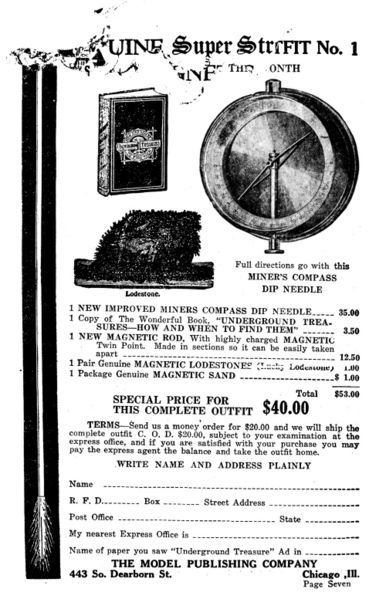Discount Prospecting Kits
 Model Publishing Company devotes several pages to discount collections of different combinations of the prospecting products they offer. Each kit includes a book, a scientific accessory of some sort, a tool of some sort, and something magnetic. The kit, above, is probably the least useful of the kits, but most telling of the rest of the catalog's offerings.
Model Publishing Company devotes several pages to discount collections of different combinations of the prospecting products they offer. Each kit includes a book, a scientific accessory of some sort, a tool of some sort, and something magnetic. The kit, above, is probably the least useful of the kits, but most telling of the rest of the catalog's offerings.This lot would be useful if it stopped at the dip needle and book -- both would be of use to an amateur prospector -- but to include so much magnetic materials with it I can only imagine that, if shipped together, the dip needle would end up severely magnetized in the wrong way. The magnetic rod appears to have some purpose beyond "finding small screws you dropped" and "magnetizing small needles" -- it seems far too deliberate in design, and I'd wager its original purpose is dowsing. There's more convenient ways to use a magnet without designing it into a metal rod with a handle/crook at the top, and advertising its 'magnetic twin point.' One of the rod's selling points is that it is "attracted by all but non-magnetic metals," which seems like a roundabout way of saying it's only attracted to magnetic metals, and seems worded to not discourage those interested in finding other hidden subterranean treasures than an iron ore deposit.
In a similar vein, but with a far different purpose, is the inclusion of a lodestone and 'magnetic sand.' While these objects hold little direct application in finding precious metals underground, many people believed (and still do) that good fortune would come to the owner of such materials. A lodestone, for the superstitious and magical, attracts wealth and success as well as it does an iron nail -- the magnetic sand represents those desired aspects of life, and the lodestone the bearer of the good luck charm. As I mentioned, the practice isn't lost to time -- you can still get a lodestone and the cutely-named 'lodestone food' from magical shops.
Labels: lodestone, magnetism, model publishing company, prospecting










